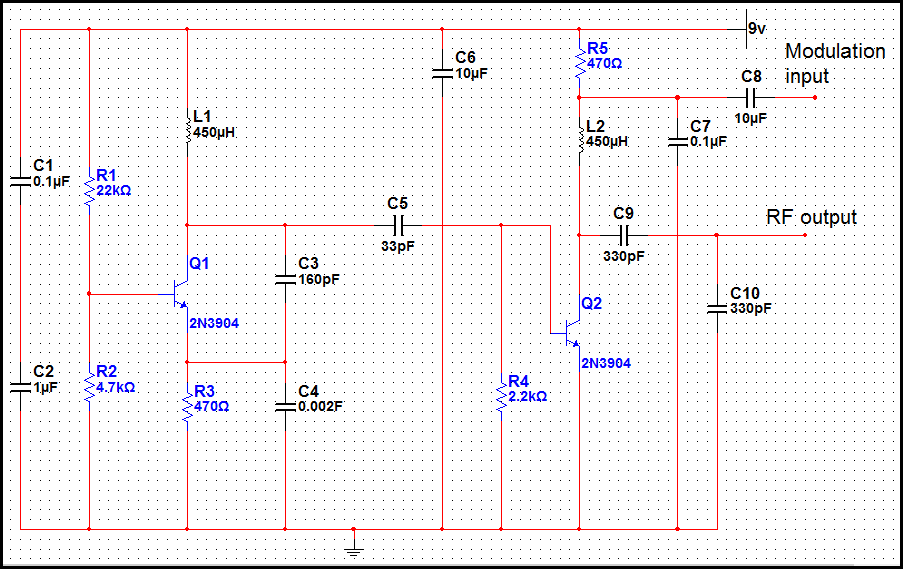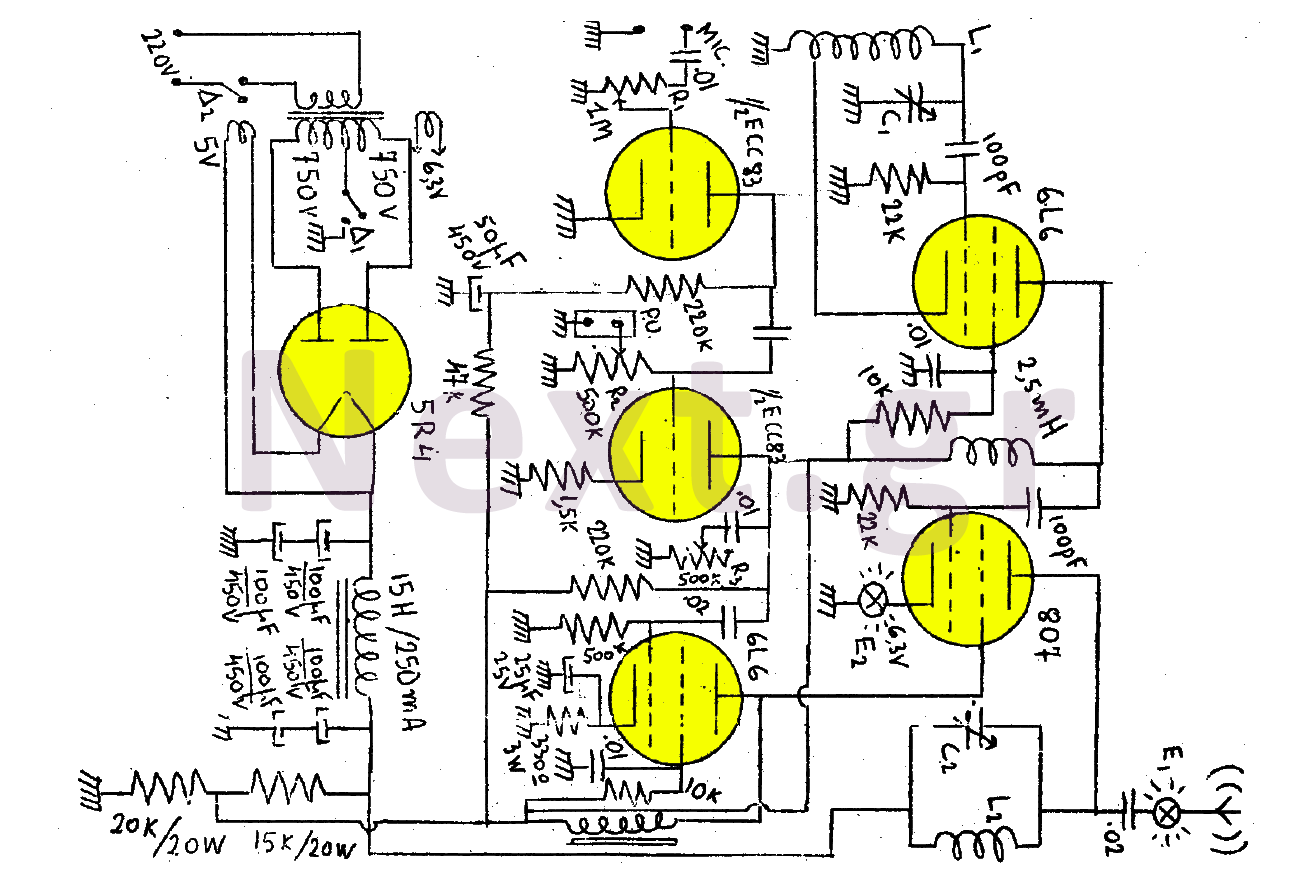
ultra miniature transmitter

This transmitter is approximately the size of a large coat button. It accepts direct voice input and operates on a single watch-type button cell, providing several tens of hours of use. The schematic illustrates that this transmitter is likely the simplest ever designed, utilizing a single transistor, a few passive components, and a small carbon button microphone. The coil is a standard medium wave (MW) spare antenna coil mounted on a small ferrite slab. The condenser microphone used is of the type typically found in tape recorders. A button trimmer is employed for tuning. There is little additional information to elaborate on regarding the circuit. Assembly in a matchbox-sized enclosure is recommended. The circuit should be constructed on a dot matrix board. The button cell can be of any variety of watch cell. To optimize reception, adjust the receiver to a dead spot. When no station is being received, speak into the microphone while adjusting the trimmer to achieve the loudest and clearest output at a certain point. Secure the trimmer in place, and the world's smallest transmitter is ready for operation.
This compact transmitter circuit is designed for simplicity and efficiency, making it an ideal project for hobbyists and beginners in electronics. The core of the circuit consists of a single transistor, which acts as the primary amplification element, allowing for voice signals captured by the microphone to be transmitted effectively. The choice of a carbon button microphone is significant, as it provides sufficient sensitivity for voice capture while remaining compact.
The use of a medium wave antenna coil on a ferrite slab enhances the transmission range and improves signal clarity. Ferrite materials are known for their magnetic properties, which help in the efficient coupling of the electromagnetic field generated by the transmitter.
The button trimmer capacitor is an essential component for tuning the transmitter to the desired frequency. This allows for fine adjustments to be made, ensuring optimal performance and minimal interference from other signals. The assembly of the circuit on a dot matrix board facilitates easy connections and modifications, which is advantageous for prototyping and experimentation.
The suggested matchbox-sized enclosure not only protects the components but also makes the transmitter portable. The design emphasizes minimalism, ensuring that the entire system remains lightweight and easy to handle.
In operation, the user is guided to adjust the receiver to a dead spot, which is a frequency where no other signals are received. This step is crucial for establishing a baseline before the voice input is introduced. By speaking into the microphone while fine-tuning the trimmer, the user can find the optimal setting for clear audio transmission. Once the best performance is achieved, the trimmer can be secured in place, finalizing the setup for ongoing use.
Overall, this transmitter circuit exemplifies a straightforward yet effective design, suitable for various applications such as personal communication devices or educational demonstrations in electronics.This transmitter has a size about that of a large coat button. The transmitter accepts direct voice input and work on a single watch type button cell that serves several tens of hours together. As shown in schematic the transmitter is probably the simplest one ever designed. A single transistor, a few passive components and a small carbon button mike do the trick. The coil is an ordinary MW spare`s antenna coil on a small ferrite slab. The condenser mike is of the type used in tape recorders. A button trimmer is used for tuning. There`s hardly anything more to be explained about the circuit. The assembly in a matchbox sized enclosure is suggested in Figure. The circuit should be made on a dot matrix board. The cell can be any kind of button(watch cell). Adjust the receiver to a dead spot. When no station is being received, begin speaking into the mike while adjusting the trimmer to obtain the loudest and clearest output at some point. Tape the trimmer there and the world`s smallest(hopefully it all depends on how you make if)transmitter is ready to transmit.
🔗 External reference
This compact transmitter circuit is designed for simplicity and efficiency, making it an ideal project for hobbyists and beginners in electronics. The core of the circuit consists of a single transistor, which acts as the primary amplification element, allowing for voice signals captured by the microphone to be transmitted effectively. The choice of a carbon button microphone is significant, as it provides sufficient sensitivity for voice capture while remaining compact.
The use of a medium wave antenna coil on a ferrite slab enhances the transmission range and improves signal clarity. Ferrite materials are known for their magnetic properties, which help in the efficient coupling of the electromagnetic field generated by the transmitter.
The button trimmer capacitor is an essential component for tuning the transmitter to the desired frequency. This allows for fine adjustments to be made, ensuring optimal performance and minimal interference from other signals. The assembly of the circuit on a dot matrix board facilitates easy connections and modifications, which is advantageous for prototyping and experimentation.
The suggested matchbox-sized enclosure not only protects the components but also makes the transmitter portable. The design emphasizes minimalism, ensuring that the entire system remains lightweight and easy to handle.
In operation, the user is guided to adjust the receiver to a dead spot, which is a frequency where no other signals are received. This step is crucial for establishing a baseline before the voice input is introduced. By speaking into the microphone while fine-tuning the trimmer, the user can find the optimal setting for clear audio transmission. Once the best performance is achieved, the trimmer can be secured in place, finalizing the setup for ongoing use.
Overall, this transmitter circuit exemplifies a straightforward yet effective design, suitable for various applications such as personal communication devices or educational demonstrations in electronics.This transmitter has a size about that of a large coat button. The transmitter accepts direct voice input and work on a single watch type button cell that serves several tens of hours together. As shown in schematic the transmitter is probably the simplest one ever designed. A single transistor, a few passive components and a small carbon button mike do the trick. The coil is an ordinary MW spare`s antenna coil on a small ferrite slab. The condenser mike is of the type used in tape recorders. A button trimmer is used for tuning. There`s hardly anything more to be explained about the circuit. The assembly in a matchbox sized enclosure is suggested in Figure. The circuit should be made on a dot matrix board. The cell can be any kind of button(watch cell). Adjust the receiver to a dead spot. When no station is being received, begin speaking into the mike while adjusting the trimmer to obtain the loudest and clearest output at some point. Tape the trimmer there and the world`s smallest(hopefully it all depends on how you make if)transmitter is ready to transmit.
🔗 External reference





